N. Sriraam1,2* , Uma Arun1
, Uma Arun1  and V. S Prakash3
and V. S Prakash3
1Department of Medical Electronics Engineering, M. S. Ramaiah Institute of Technology, Bangalore, India.
2Center for Medical Electronics and Computing, M. S. Ramaiah Institute of Technology, Bangalore, India.
3Department of Cardiology, M.S Ramaiah Medical College and Hospitals, Bangalore, India.
Corresponding Author E-mail: sriraam@msrit.edu
DOI : https://dx.doi.org/10.13005/bpj/2832
Abstract
Background: Personal health monitoring with wearable electronics has gained momentum in the recent years due to its usage in flexible textile-based sensors/electrodes for recording of physiological vital parameters. Such system provides scope for long term ambulatory ECG measurement and motion tracking applications. The selection /design of textile sensors play a vital role as it has to overcome skin irritations, improve the skin-electrode impedance required for conductivity. The composition of textile materials, shape and size of the textile electrodes contributes significantly towards the conductivity. Objective: To assess the proposed Cardif system for its suitability to introduce in the clinical routine Method: The proposed textile electrodes were designed using knit jersey conductive material. The skin –contact impedance of the proposed textile material, was measured using two electrode impedance method and measurement was done for different age groups by varying the frequency. Results: The measurement results showed that the impedance was decreasing with increasing frequency and was found to be below 1.5Mohm/cm2 in the frequency range of 20Hz to 1KHz for three different age groups. The performance of the CARDIF was assessed using heart rate, RR interval, SNR as well as qualitative assessment through visual inspection and were compared with gel based disposable Ag/AgCl electrodes. Qualitative and quantitative analysis was performed and the various results confirm the proposed textile electrodes for continuous patient monitoring applications.
Keywords
Cardiac monitoring; Continuous Monitoring; ECG; Fidelity Measures; Textile Electrodes
Download this article as:| Copy the following to cite this article: Sriraam N, Arun U, Prakash V. S. Performance Evaluation of Cardiac Signal Recording Framework (CARDIF)-A Quantitative Assessment for Long Term Monitoring Applications. Biomed Pharmacol J 2024;17(1). |
| Copy the following to cite this URL: Sriraam N, Arun U, Prakash V. S. Performance Evaluation of Cardiac Signal Recording Framework (CARDIF)-A Quantitative Assessment for Long Term Monitoring Applications. Biomed Pharmacol J 2024;17(1). Available from: https://bit.ly/3U4hj5M |
Introduction
The impact of wearable physiological monitoring system towards personalized healthcare and quality of lifestyle on daily basis can be well understood through current wearable devices available in the global market. Though this technology has created revolution in developed countries, it is to yet to reach the underdeveloped countries especially for resource-constrained settings. Due to the device development cost and reliability, there is a huge demand to cater to the needs of mid and low-income countries. Attempts have been made to develop wearable systems, but mostly it gets stopped at the academic laboratories. Translation from prototype to product, commercialization and market potential requires huge investments and due to this, the accessibility of such devices is still a dream for low-income countries. In the recent years wearable technology growth has created huge impact on the healthcare sector especially towards homocentric applications by lowering the cost factor without sacrificing the required clinical diagnostic requirements. This has shown the path for under developing countries towards design and development of wearable physiological monitoring devices.
Long term electrocardiogram (ECG) recordings assessment is very important for recognition of various cardiac episodes including syncope, palpitations etc.,1. Such automated computer aided quantitative assessment provides alerts to the patients and real-time qualitative annotation can be performed by the cardiologist remotely to understand the severity level. Hence there is a greater demand for developing external cardiac loop recorders, which can store the cardiac episodes for longer duration and the real time assessment of the cardiac activity by the cardiologist 2.
Most of the electrodes used for ECG data acquisition are gel-based Ag/AgCl surface electrodes. These surface electrodes have to be used with conductive gel to establish proper conductive path to acquire the bio-potentials. But, if it is used for longer duration, drying up of gel causes rise in skin-electrode contact impedance and also causes skin-irritation or rashes . These gel-based electrodes cannot be used repeatedly as they are not reusable. To avoid all these problems and to acquire ECG signal for long duration, textile electrodes are widely researched and proven to be beneficial in acquiring bio-potentials. Hence, textile electrodes seemed to be promising alternatives for continuous and long-term cardiac monitoring compared to gel-based electrodes3-11.
Due to its inherent conductive properties, textile based dry electrodes are being designed as ECG sensors for continuous monitoring applications and such electrodes are less susceptible to artifacts. It is well-known fact that choosing textile materials for such applications merely depends on the material’s durability, reusability and launderability. 9-12. The objective of this study is to make use of conductive textile material as a biopotential sensor for long term ECG monitoring Applications at an affordable cost to cater the need of resource constrained settings. Though several attempts have been made, the scope for new sensor design still emerge due to the need for low cost sensor design requirements.
This specific study highlights the performance evaluation of cardiac signal recording framework (CARDIF) that consists of dry ECG electrodes as sensor with an AFE unit and Xilinx real time processor. Knit jersey conductive material was considered to design the dry ECG electrode as the sensing unit. The skin –contact impedance of the proposed textile material, was measured using two electrode impedance method and measurement was done for different age groups by varying the frequency. The measurement results showed that the impedance was decreasing with increasing frequency and was found to be below 1.5Mohm/cm2 in the frequency range of 20Hz to 1 KHz for three different age groups. The performance of the CARDIF was assessed using Heart rate, RR interval, SNR as well as qualitative assessment through visual inspection and were compared with gel based disposable Ag/AgCl electrodes.
Background for the Proposed Study
Related Work
A wrist based Electrocardiography’s performance was designed and its performance was reported3. A CamNtech recorder was used where three pre-gelled surface electrodes were placed on the non-dominant hand and the fourth one on the chest. The heart rate was measured and the study showed that the motion artifacts were nullified. The study confirmed the suitability for designing low power wearable settings. A specific study was reported by 14 towards developing smart garment for cardiac mechanical performance. The main focus was to monitor the physiological changes during sleep and assess the mechanical variation of the heart. The smart wearable system comprised of sensorized vest, electronic module, external module for thoracic skin temperature and the battery unit. The study was conducted by Italian space Agency. A multiparameter wearable system was proposed by 15 to assess the cardiopulmonary functionalities. Gait analysis was integrated with the physiological parameters analysis and the study showed a potential way towards developing assistive tools.
Conductive yarns form the basis for the textile sensors where process such as knitting, weaving, printing of conductive polymers on nonconductive fabrics were introduced for the formation of conductive yarn 16. Several textile based electrodes were reported for measurement of ECG17-26. A hybrid textile electrode has been proposed for ECG measurement [16] and motion tracking. A silver-plated weft knitted conductive fabric was used along with the flexible motion sensor circuit. It was shown that the proposed approach ensured a synchronized mechanism between the two modalities.
It is a well-known fact that the conventional (Ag/Ag Cl )rigid metal plate electrode provides good conductivity through usage of the gel on the skin surface.Such gel often causes skin irritation and allergy. For wearable home centric applications textile based sensors/electrodes provides more flexibility than the conventional electrodes. Textile electrodes are dry/gel less based, soft in nature and its efficiency relies on the selection of material and its composition. Furthermore, these electrodes can be integrated into textile garment for making smart wearable T shirts for long term monitoring. The electrodes can be washed, reused and the cost factors can be brought down by making use of locally available electronic assembly thereby making it suitable for resource constrained settings. Due to such factors, several attempts have been made in the past to introduce textile based sensors/electrodes. A specific study was made to recognize the best textile materials for the development of capacitive Biosensors 27. Six common textile materials and their characteristics were studied. A capacitance driven biosensor was designed and evaluated onthe electromyography signals 28
There are two variants of electrodes for developing biosensors, contact based wet electrodes and noncontact dry electrodes. The bio signal which gets generated depends on the electrode-skin interface where typical Ag/AgCl based conductive gel are applied to reduce the impedance between the skin electrode to improve the signal quality. Such procedure leads to skin irritation, allergy to patients. Hence such wet electrodes do not suit for wearable monitoring applications. On the other hand, attempts have been made to introduce gel less dry electrodes. 14,29-30.In the recent years textile based dry electrodes as biosensors have been proposed by several researchers for bio signal measurements,31-37.
While designing textile electrodes, one has to give much consideration to contact impedance, conductive capability of the material, SNR of the resultant ECG signal, resistance/capacitance, material conductive area and shape of the textile material. The composition of textile materials plays an important role towards conductivity (better impedance between the skin and the electrode). Thereby making the resultant ECG signal to be good enough to make required diagnosis by the clinical community. Cotton based fabrics are ideally preferred for use as textile electrodes that provide more comfort ability to the user, than the use of cotton blended yarn.
A 3 channel wearable ECG was demonstrated by10. A real-time ECG recording monitoring system was proposed [38]. A specific study on ECG signal acquisition using standard Ag-Agcl electrodes with a reconfigurable real-time embedded processor with a virtual instrumentation platform was done. The study showed that single channel ECG from Lead Iand configured recordings could be interpreted with vital values displayed directly.The system consisted of real-time Xlinix processor and Labview platform.
An IoT cloud based real-time heart rate monitoring system was reported [39]. A reconfigurable embedded processor with wireless capability and virtual instrumentation Labview platform was used and IBM Watson IoT platform was used to process the data in cloud. The pilot study showed the possibility of configuring multi parameter monitoring system for telemedicine and smart rural healthcare services .
An IoT based Wi-Fi connected sensor for ECG recordings and monitoring of vital parameters was reported recently [40]. A low powered micro controller was used with TI CC 3100 Wi-Fi booster package to establish wireless communication from IoT module to Cloud platform.
A wearable ECG monitoring system for resource constrained settings was proposed 41. The study showed the usage of limb electrodes for recordings of ECG signals with NI Myrio processor. The preliminary reported results showed that the study needed to be validated with large datasets. Further no attempt was made to test the efficiency of the textile material used for recording the ECG signals.
A pilot study with Indian population was proposed by 42 towards the assessment of ECG signals. A smart textile electrode belt was proposed and the experimental study was carried out with 147 healthy volunteers. The variation with heart rate was studied and the pilot study revealed that the proposed textile based ECG electrodes yielded comparable fidelity measures same as that of the standard Ag-Ag Cl gel based ECG electrodes.
A specific study on woven conductive dry textile electrodes was reported for continuous ECG signal recordings 43. Two woven conductive textile materials were used and wearable electronics assembly was configured to record the ECG signals. Lead I configuration was adopted and the performance of the recorded signal was evaluated qualitatively by visual inspection by the clinician and quantitatively by fidelity measures.
A specific study has been proposed for animal ECG recordings using a wearable approach49 where needle based electrodes were used to acquire the signal. With the advent of AI processor, a wearable ECG classification was reported [50] where the authors have shown the efficiency of the efficient cardiac classification using the recordings obtained through wearable ECG system. In order to analyze the long-term ECG recordings from the wearable patch recorders51, a specific signal processing framework was proposed which shows the effective usage of patch recorders for signal recording and qualitative assessments
Standard Disposable Electrode
Attempts have been made in the past to design biomedical electrodes based on its conductivity requirement. From materials conductive perspective, electrodes are referred as capacitive and resistive 44. According to 44,45 from functional point of view, it can be categorized into recording and defibrillation electrodes. Further classification are also available including wet and dry 45, flexible and rigid. The most common gold standard electrodes used in clinical recordings is the resistive electrode, Ag/Agcl. The wet gel electrolyte is essential for such electrodes to improve the skin conductivity. For brevity and understanding metal plate disposable ECG electrodes is shown in Fig.1.
The Ag/AgCl electrode is reliable even in extreme situations due to hypoallergenic adhesive and quick-recovery gel. It has a defibrillation-resistant Ag/AgCl sensor which is subjected to a strict quality control during production.
 |
Figure 1: Metal-plate ECG electrodes: top view (left), bottom and cross-section view 4, 45 |
Materials and Methods
Design of Textile Electrode
The selection of the textile materials plays an important role towards the design of dry sensors. The material should have the capability of bending, stretching, twisting, rubbing etc., Further the preferred material for the electrodes should possess characteristics, such as, low AC impedance, non-polarizable , electrochemical stable, and mechanical robustness, etc. For better clarity, Table A1 as reported in Annexure A shows the commonly used electrode materials and its associated properties. For the current research, we have chosen the knot jersey as the conductive material which has the composition of spandex, cotton and silver yarn. Table 1 shows its characteristics.
Table 1: Properties and characteristics of the Textile material
|
Type of material |
Composition |
Electrode Surface Area A (mm2) |
Electrode Resistance (Ω) |
Thickness d (mm) |
Skin-Electrode Impedance (Ω) |
Physical Characteristic |
|
Knit Jersey |
63% cotton, 35% silver yarn 2% spandex |
1000 mm2 |
46Ω/foot (across rows) 460Ω/foot (across column) |
1mm |
2.2MΩ |
absorbent, breathable, elasticity |
The proposed textile electrodes comprise of two numbers of 50 mm x20 mm rectangle pieces that were stitched in such a manner that high impedance with better conductivity is assured in the inside portion. A medical grade snap button was stitched at the center portion of the textile electrode by ensuring that the button doesn’t touches the skin. Then finally the wrist band was developed using the textile material stitched using a conductive thread and attached with a Velcro. Figure 2 shows the snap shot of the proposed textile material as a wrist band for this research study.
 |
Figure 2: Proposed Textile Material |
The electrode coupling model contains textile electrode on top of body and skin as shown in Figure 3a .The three element model of skin impedance, which represents capacitance and resistance is shown in Figure 3b. The skin impedance is a combination of resistance and capacitance arranged parallel or serial. The three-element model is used to describe skin impedance at different frequencies. At high frequency, the impedance of the capacitance 1/(ωCd )is less than Rd , hence Rd is shortcircuit and the impedance is constant at R . At low frequency, the capacitance 1/(ωCd)is greater than Rd , and the impedance is constant at R + Rd .
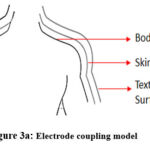 |
Figure 3a: Electrode coupling model |
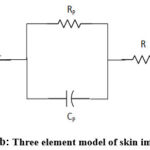 |
Figure 3b: Three element model of skin impedance |
Three wrist bands of same size were stitched and attached to right arm, right wrist and left arm The impedance of this material was determined first before performing the measurement of bio signal. The impedance was measured using an LCR meter, which had an isolation amplifier. The textile electrode was connected at the center and the standard Ag/AgCl electrodes were connected on both sides at about 5 cm away. The arrangement of textile electrode and disposable electrodes are shown in Figure 4a. The two reference Ag/AgCl electrodes were kept at ‘a’ and ‘c’. The textile electrode was at the location ‘b’. The skin – electrode contact impedance can be determined as per the model shown below. Let Zab be the impedance between the center textile electrode and the Ag/AgCl electrode on one side and Zbc be the similar impedance on the other side.
 |
Figure 4a: Skin-Textile Electrode Model |
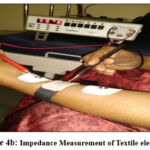 |
Figure 4b: Impedance Measurement of Textile electrode. |
The unknown impedance Zx can be found out from the relation Zx = Zab-Zac/2, where Zac was the impedance between the two standard Ag/AgCl electrodes that were connected 10 cm away. The experiment set up for impedance measurement is shown in Figure 4b. The skin-electrode and contact impedance measurement were done for different age groups. The age group of 18-24 was Group I, 25-40 was Group II and 45-60 was Group III. The impedance was measured for three different frequencies and they are listed in ANNEXURE B. Table B1 for Group I, Table for Group II and Table B3 for Group III.
The human skin conductivity when it gets dry, varies from 10-7 mhos for lower frequency and it will changes to 10-4 for higher frequencies. The conductivity of the human skin when it gets wet varies from 10-5 for lower frequency and it will go to10-4 for higher frequencies.
CARDIF Setup
In this proposed study, single ECG recording and analysis using CARDIF was implemented by textile electrodes with lead I configuration. An analog front end amplifier was configured with real time reconfigurable input output processor. The block diagram of the CARDIF setup is shown in Figure 5.
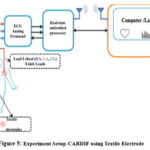 |
Figure 5: Experiment Setup-CARDIF using Textile Electrode |
Study Design
In order to evaluate the proposed textile ECG electrode based CARDIF,a pilot study was conducted with healthy volunteers for a period of 20 months. An overall sample n=270(M=122,F=148)was considered. The volunteers were in the age group of 19-50 years and all of them belong to south India. Those who had symptoms of blood pressure and diabetics were excluded for this study. All procedure performed in the proposed work involving human participants were in accordance with the ethical standards of Ramaiah Medical College and hospital and also in accordance with the 1964 Helsinki declaration and its later amendments or comparable ethical standards. Subject consent form was obtained from every individual after briefing the importance of the proposed study. According to Einthoven lead configurations, single channel lead I was considered. Though precordial leads (v1,v2) was carried out for the study,due to non-cooperation from female participant, the proposed study reported only lead I configuration study.
As the main aim of the study is to test the efficiencies of the suggested textile ECG electrodes, wo trials each with 180 minutes was considered. A gap of three weeks was given between the two trials. During the subjects recordings, there were no significant changes found between the trial 1 and trial 2 recordings. All the recordings were conducted in a sound proof room with subject kept in supine position. Figure 6 shows the experiment setup of the textile system using CARDIF.
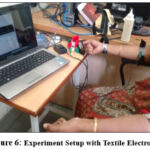 |
Figure 6: Experiment Setup with Textile Electrodes |
Evaluation Metrics
The performance of the proposed textile electrodes based CARDIF is evaluated in terms of fidelity parameters, visual inspection by clinicians, characteristics of ECG and statistical significance were also studied. The important parameters were calculated as follows,
RR interval is the duration in seconds between the adjacent R peaks in the ECG signal. It is the time interval between Ri and Ri+1 wave of the ECG signal. Heart rate is the speed of the heartbeat measured by the number of contractions of the heart per minute. It is the ratio of the number of R peaks occurring in a minute. The duration of the RR interval is measured and Heart Rate is calculated using (1)

For the QRS wave, the average value and the CV was also calculated. The coefficient of variation (CV) is a statistical measure of the dispersion of data points in a data series around the mean.
The QRS amplitude was defined as the difference between the value at the R peak and the minimum value in the Q and S peaks. The SNR and CV were derived with Equations (2) and (3), respectively[46].


where μA and σA are the mean and standard deviation of A, respectively, and μB and σB are the mean and standard deviation of B. N is the length of the sequence.
The baseline details of the study group were given in the Table 2 which includes gender, age, height, weight, BMI and Systolic/Diastolic pressure.
Table 2: Baseline details of study group.
|
No of Subjects |
Age |
Height in cm |
Weight in Kg |
BMI |
Systolic/Diastolic pressure |
||||||
|
Male |
Female |
Male |
Female |
Male |
Female |
Male |
Female |
Male |
Female |
Male |
Female |
|
122 |
148 |
26±6.3 |
29±4.8 |
161±4.4 |
154±2.3
|
65±7.2 |
58±4.3 |
26±1.3 |
25±1.4 |
124/83 |
121/81 |
Performance Evaluation
Skin-Impedance Characteristics
The skin electrode contact impedance was found out for three different age group for various frequencies. In each group twenty people were considered and it was measured using LCR meter. Lower age group had less impedance compared with the upper age group for all the frequencies. As the frequency increases, the skin electrode contact impedance decreases. All the contact impedance was less than 5 MΩ, which is essential for the textile material to be used as an electrode. In addition, the skin electrode and contact impedance increased with age. Lower age group I had less impedance compared with the upper age group III for all the frequencies. So, the textile material could be used as an electrode on par with disposable electrode. Figure 7 shows the variation of the impedance with respect to the frequency.
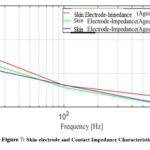 |
Figure 7: Skin-electrode and Contact Impedance Characteristics |
It can be inferred from Fig.7 that the increase in frequency results in the decremental impedance which is very much essential for the skin conductivity. Further usage of dry ECG sensor ensure better skin conductivity which can be very used for long term wearable recordings. With different age group, the skin electrode impedance ensures better conductivity thus making the proposed dry ECG sensor as better candidate for ECG recordings
ECG Characteristics
A sample waveform obtained from the textile electrodes is shown in Figure 8 with differentECG components.
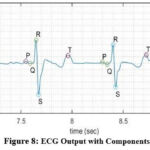 |
Figure 8: ECG Output with Components |
It can be inferred from the waveform shown in Figure 8 that the presence of all ECG fidelity confirms the typical ECG signal requirements for analysis and ensures the suitability of proposed dry ECG sensor for data recordings.
The values of the different components of ECG signal such as P wave, QRS complex, T wave and PR interval from reference and textile electrodes were shown in Table 3. The values obtained from the textile electrodes were found to be close to the values obtained from the reference electrodes as well as with the Standard American Heart Association clinical values.
Table 3: Values of components of ECG from Standard American Heart Association clinical values, referenceAg/Agcland Textile Electrodes
|
Wave |
Standard American Heart Association Clinical Values |
Reference Electrode(Ag/AgCl) |
Textile electrodes |
|
P |
<0.08s |
0.05 s |
0.06 s |
|
QRS |
0.08 to 0.10s |
0.05 s |
0.06 s |
|
T |
0.16s |
0.15 s |
0.14 s |
|
PR |
0.12s to 0.20s |
0.10 s |
0.11 s |
|
QT |
<0.44s |
0.35 s |
0.31 s |
|
RR |
1 s |
0.84 s |
0.88 s |
It can be inferred from Table3 that the proposed designed ECG sensor/electrodes found to yield the necessary fidelity duration to confirm the normal functionality of the heart.
Fidelity Measures
The ECG Output from disposable Ag/AgCl electrode and the output obtained from Textile electrodes are shown in Figures 9 and 10 respectively.
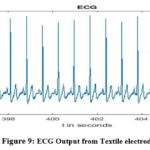 |
Figure 9: ECG Output from Textile electrode |
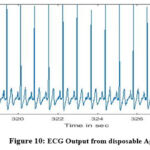 |
Figure 10: ECG Output from disposable Ag/Agcl |
The selected ECG parameters were obtained for all the subjects using textile electrode. The average and standard deviation of these parameters are shown in Table 4 along with the results obtained from disposable Ag/AgCl electrode.
Table 4: Results of Textile Electrodes and Disposable Electrodes
|
Parameters |
Textile Electrodes |
Disposable Ag/AgCl Electrodes |
|
Mean ±SD |
Mean ±SD |
|
|
Heart rate(BPM) |
83.44±3. 70 |
98.15±4.758 |
|
RR in sec |
0.6857±0.115 |
0.6159±0.289 |
|
RMS in mv |
0.9913±0.031 |
0.9935±0.106 |
|
MAX in mv |
3.27±0.08 |
3.1±0.07 |
|
MIN in mv |
1.20±0.06 |
1.1±0.08 |
|
Vpp in mv |
3.18±0.821 |
3.02±0.60 |
|
AVGPSD |
-5.05±0.271 |
-4. 5±0.74 |
|
SNR in dB |
9.2±0.73 |
10.4±0.26 |
|
Range |
0.58s |
0.41s |
|
Variance |
0.013s |
0.010s |
It can be seen from Table 4 that the fidelity measure obtained using the wet and dry sensors were lying with in the range acceptable by the cardiology community. Further signal to noise ratio seems to be better for the dry sensors using the textile electrodes and makes it usable for long term monitoring applications. In the case of wet disposable electrodes, due to application of gel skin irritation as well as loss of conductivity occurs if used for longer duration
The raw ECG data was processed by low pass with Fl= 40Hz and high pass with Fh=0.5Hz.The base line wandering removal was done and R peak was extracted using Pan Tompkins algorithm.The raw ECG and output after baseline wandering removal is shown in Figure 12.
 |
Figure 11: Raw ECG and Output after Baseline Wandering Removal |
The result shows that the values obtained from textile electrodes are comparable with that taken from standard disposable electrode.Using Box plot, SNR and HR were determined.The SNR box plot was obtained with disposable and textile electrodes is shown in Figure 12 .
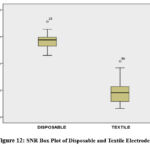 |
Figure 12: SNR Box Plot of Disposable and Textile Electrode |
The results show that there is a considerable improvement in the signal to noise ratio of the textile electrodes compared with the disposable electrodes. The Box plot for Heart rate ( BPM )is shown in Figure 13.
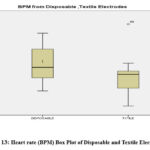 |
Figure 13: Heart rate (BPM) Box Plot of Disposable and Textile Electrode |
The heart rate ( BPM )obtained from both the methods were almost same range within the limits of ideal values. So the textile electrodes were comparable with disposable electrodes. Figure 14 illustrates the Bland–Altman analysis of differences in HR between textile electrode signal and disposable electrode signal. The average of the differences is 0.76 units. The mean difference is not zero, which infers the textile electrode measures 0.76 beats/min more than that of the disposable electrode. It demonstrated insignificant bias because almost all differences remained in the 95% confidence interval (23 [–22 – 24] beats/min).
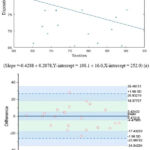 |
Figure 14: (a) Regression Analysis and (b) Bland Altman Plot of HRV(BPM) interval from Disposable and Textile Electrode |
 |
Figure 15: (a)Regression Analysis and (b) Bland Altman Plot of RR interval from Disposable and Textile Electrode |
From Figure 14, it can be observed that the Confidence Interval (CI) of mean difference and limits of agreement describes less possible error estimates. It indicates that the difference between HR measured by textile electrodes and disposable electrodes is less significant. The coefficient of correlation between HR derived by the textile electrode signal and disposable electrode signal was significant (p < 0.0001). Figure 15 illustrates the Bland–Altman analysis of differences in RR between textile electrode signal and disposable electrode signal. The average of the differences is zero units. The mean difference is zero, which infers the textile electrode measures the same RR as that of the disposable electrode. It demonstrated insignificant bias because almost all differences remained in the 95% confidence interval (0.32 [–0.32 – 0.31] sec). It shows clearly that the parameters HR and RR interval obtained using textile electrodes were similar to the disposable electrodes.
Discussion
Attempts have been made in the past towards developing textile electrodes for continuous ECG recordings [16][31][47][48]. The PEDOT:PSS based dry ECG electrodes were developed by making use of stringent procedure as reported by [47]. Ten healthy volunteers were involved for this study and fidelity measures confirms the suitability of PEDOT electrodes for continuous recording of ECG signals. It can be observed from the reported research study that the fabrics of the dry electrodes were doped with chemical solution for achieving better conductivity. The process found to be amber some and huge cost factor found to be involved.
A similar attempt has been made by 31 where silver coated nylon thread embroidered on polyster was used as conductive textile electrodes. The electronic circuity assembly information was not reported and ten volunteers were involved for the study. Though 9 suggested a hybrid textile electrode for ambulatory ECG measurement, the integration of circuit board and conductive fabric were found to be complex in nature. The number of test sample considered for the study was not reported. The quality of the resultant ECG signals suffers severely due to baseline drift and high frequency noises. A textile based inductive sensor for measurement of heart rate and respiration was proposed 18.Lead II configuration was adopted and electromagnetic characterization of the proposed sensor was studied. The complexity of the proposed sensor in term of cost involved towards design, reusability was not reported.
The proposed textile electrode was evaluated for comfort and longevity. Unlike the traditional Ag/AgCl electrodes where factors such as gel dryness contributes significantly, the proposed electrode was evaluated for 8 hours with selective group (n=31) and the resultant ECG recordings were assessed qualitatively by a clinician. The fidelity measures confirm the suitability of the recordings for clinical diagnosis. A smart wearable garment is under development by considering the Lead I and Lead III configuration. Due to non-cooperation of female volunteers, the proposed study doesn’t include the chest-based textile electrode recordings and the corresponding fidelity measurements.
With the proposed framework, all significant components of ECG, QRS complex, P wave, T wave, RR interval were able to be detected by the automated algorithm. The proposed framework suits well for low cost and resource-constrained settings for screening of cardiac episodes, early detection of arrhythmias etc. The textile electrode was washed 10 times and study was conducted to check the quality of the resultant ECG recordings. Through clinician’s inspection, it was informed that the conductivity of the proposed textile sensors embedded in smart wearable garment could be explored for home-centric wearable monitoring applications. The overall specification of the proposed CARDIF is shown in Table 5.
Table 5: Specification of the proposed CARDIF
|
Parameter |
Specification |
|
Max current consumption |
4 mA |
|
Battery life cycle |
5 hours |
|
ADC Sampling Rate |
Aggregate sample rate 500 Hz |
|
Max communication range |
Wireless |
|
Weight |
193 g(6.8 oz) |
|
Dimension(LxBxH)of CARDIF |
9cm x 6cm x 2cm |
|
ECG signal resolution |
12 bits |
|
Non volatile memory |
512MB |
The average QRS amplitude of the textile electrode and the disposable electrode was found out for two male and two female subjects. The coefficient of variance was also found out for each case.Table6 shows the results obtained from both variant electrodes. It can be noticed that the results were found to be comparable with the earlier reported work[46].
Table 6: Average QRS amplitude and coefficient of variance
|
Sub No |
Gender |
Disposable |
Textile |
||
|
Average QRS Amplitude (mV) |
CV of QRS Amplitude |
Average QRS Amplitude (mV) |
CV of QRS Amplitude |
||
|
Sub1 |
Male |
2.0385 ±0.1682 |
0.0825 |
0.4532±0.0921 |
0.2033 |
|
Sub2 |
Male |
1.3419 ± 0.0824 |
0.0614 |
0.1877±0.1877 |
0.0895 |
|
Sub3 |
Female |
2.4194±0.1491 |
0.0616 |
0.4655±0.0631 |
0.1355 |
|
Sub4 |
Female |
2.3992±.2786 |
0.1161 |
0.4380±0.0314 |
0.0716 |
The quality of the ECG signals obtained using CARDIF with wet electrodes (Ag/Agcl disposal) and dry electrodes (proposed textile electrodes) were correlated and the resultant regression analysis is shown in Fig.16
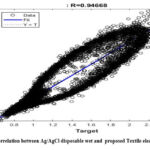 |
Figure 16: Correlation between Ag/AgCl disposable wet and proposed Textile electrode signals. |
The analysis result showed that the ECG signal from the textile-based electrodes were highly associated with the signals obtained through the Ag/AgCl gel based wet electrodes (R=0.94668).The value of R will vary from +1 to -1.The obtained R value which is positive with close to 1, shows that there exists a strong correlation between both the methods.
The ECG signals obtained from the CARDIF using textile electrodes were compared with the research grade Active Cardio ECG system using gel based Ag/AgCl disposable electrodes. It can be seen from Fig,17 that the proposed CARDIF is very well correlated with the research grade active cardio system with correlation coefficient of R= 0.92282,.
 |
Figure 17: Correlation between CARDIF (Textile electrode) and Active cardio (Ag/AgCl electrode). |
Conclusion
A cardiac signal recording framework (CARDIF) has been proposed by making use of dry textile knit jersey based conductive electrodes in this proposed study. The acquired electro cardiogram (ECG) signals were quantitively assessed in terms of impedance characteristics, fidelity measures and were compared with that of standard wet Ag-Agcl electrodes. The qualitative assessment by the clinician along with the fidelity result confirms the suitability of the proposed framework for continuous and long-term monitoring application. Further the physiological variation in terms of R-R interval, heart rate variability assessed during the experimental period (20 months) confirms the suitability of CARDIF for resource constrained settings due to its low cost design. Currently flexible electronics driven miniaturization work is undergoing to develop a compact module suitable for long term cardiac monitoring. As a future study, application of nanomaterial based sensor design will be carried out to enhance the efficacy of the proposed system.
Credit Author Statement
Sriraam and Uma Arun designed the proposed CARDIF system and performed the quantitative assessment and Prakash did the clinical validation of the proposed system. Sriraam prepared the conceptualization of the manuscripts and all authors have endorsed the content.
Conflict of Interest
There is no conflict of interest involved in this study.
Funding Source
This work was supported by the Department of Biotechnology (DBT), Government of India. Ref. No.: BT/PR14751/MED/32/422/2015.
Reference
- Jenkins, C. (1998). Essentials of Learning Electrocardiography. A Complete Course for the Non Cardiologist: J. Constant. Parthenon Publishing. 1997, 226 pp.
- Arun, U., & Sriraam, N. (2019). A Study on Developing Cardiac Signals Recording Framework (CARDIF) Using a Reconfigurable Real-Time Embedded Processor. International Journal of Biomedical and Clinical Engineering (IJBCE), 8(2), 31-44.
- Sun, F., Yi, C., Li, W., & Li, Y. (2017). A wearable H-shirt for exercise ECG monitoring and individual lactate threshold computing. Computers in industry, 92, 1-11.
- Xu, P. J., Zhang, H., & Tao, X. M. (2008). Textile-structured electrodes for electrocardiogram. Textile progress, 40(4), 183-213.
- Akbulut, F. P., & Akan, A. (2018). A smart wearable system for short-term cardiovascular risk assessment with emotional dynamics. Measurement, 128, 237-246.
- Pandian, P. S., Mohanavelu, K., Safeer, K. P., Kotresh, T. M., Shakunthala, D. T., Gopal, P., & Padaki, V. C. (2008). Smart Vest: Wearable multi-parameter remote physiological monitoring system. Medical engineering & physics, 30(4), 466-477.
- Kirstein, T., Cottet, D., Grzyb, J., & Tröster, G. (2002, October). Textiles for signal transmission in wearables. In Proc. ACM of First Workshop on Electronic Textiles (MAMSET 2002), San Jose, CA (Vol. 3, pp. 47-51).
- You, I., Choo, K. K. R., & Ho, C. L. (2018). A smartphone-based wearable sensors for monitoring real-time physiological data. Computers & Electrical Engineering, 65, 376-392.
- Sarmento, A., Vignati, C., Paolillo, S., Lombardi, C., Scoccia, A., Nicoli, F., Mapelli, M., Leonardi, A., Ossola, D., Rigoni, R. and Agostoni, P., 2018. Qualitative and quantitative evaluation of a new wearable device for ECG and respiratory Holter monitoring. International journal of cardiology, 272, 231-237.
- Despang, HG, Netz, S., Heinig, A., Holland, HJ, & Fischer, WJ (2008). Wireless long-term ECG integrated into clothing / wireless long-term ECG integrated into clothing.
- Searle, A., & Kirkup, L. (2000). A direct comparison of wet, dry and insulating bioelectric recording electrodes. Physiological measurement, 21(2), 271.
- Castelletti, S., Dagradi, F., Goulene, K., Danza, A. I., Baldi, E., Stramba-Badiale, M., & Schwartz, P. J. (2018). A wearable remote monitoring system for the identification of subjects with a prolonged QT interval or at risk for drug-induced long QT syndrome. International journal of cardiology, 266, 89-94.
- Casson, A. J. (2014, May). Performance of wrist based electrocardiography with conventional ECG analysis algorithms. In 2014 8th Conference of the European Study Group on Cardiovascular Oscillations (ESGCO) (pp. 11-12). IEEE.
- Di Rienzo, M., Vaini, E., & Lombardi, P. (2018). Development of a smart garment for the assessment of cardiac mechanical performance and other vital signs during sleep in microgravity. Sensors and Actuators A: Physical, 274, 19-27.
- Li, H., Yuan, D., Ma, X., Cui, D., & Cao, L. (2017). Genetic algorithm for the optimization of features and neural networks in ECG signals classification. Scientific reports, 7(1), 1-12.
- An, Xiang., & Stylios, G. K. (2018). A hybrid textile electrode for electrocardiogram (ECG) measurement and motion tracking. Materials, 11(10), 1887.
- Pani, D., Achilli, A., Bassareo, P. P., Cugusi, L., Mercuro, G., Fraboni, B., & Bonfiglio, A. (2016, September). Fully-textile polymer-based ECG electrodes: Overcoming the limits of metal-based textiles. In 2016 Computing in Cardiology Conference (CinC) (pp. 373-376). IEEE.
- Gi, S. O., Lee, Y. J., Koo, H. R., Khang, S., Kim, K. N., Kang, S. J., … & Lee, J. W. (2015). Application of a textile-based inductive sensor for the vital sign monitoring. Journal of Electrical Engineering and Technology, 10(1), 364-371.
- Alesanco, A., & Garcia, J. (2010). Clinical assessment of wireless ECG transmission in real-time cardiac telemonitoring. IEEE Transactions on Information Technology in Biomedicine, 14(5), 1144-1152.
- McKnight, M., Agcayazi, T., Kausche, H., Ghosh, T., & Bozkurt, A. (2016, August). Sensing textile seam-line for wearable multimodal physiological monitoring. In 2016 38th Annual International Conference of the IEEE Engineering in Medicine and Biology Society (EMBC) (pp. 311-314). IEEE.
- Chattaraj, R., Bhaumik, S., Khan, S., & Chatterjee, D. (2018). Soft wearable ionic polymer sensors for palpatory pulse-rate extraction. Sensors and Actuators A: Physical, 270, 65-71.
- Chung, D., Choi, J., Jang, J.H., Kim, T.Y., Byun, J., Park, H., Lim, H.S., Park, R.W. and Yoon, D., 2018. Construction of an electrocardiogram database including 12 lead waveforms. Healthcare informatics research, 24(3), 242-246.
- Corbishley, P., & Rodriguez-Villegas, E. (2007). Breathing detection: towards a miniaturized, wearable, battery-operated monitoring system. IEEE Transactions on Biomedical Engineering, 55(1), 196-204.
- Nemati, E., Deen, M. J., & Mondal, T. (2012). A wireless wearable ECG sensor for long-term applications. IEEE Communications Magazine, 50(1), 36-43.
- Zeitler, E. P., & Piccini, J. P. (2016). Remote monitoring of cardiac implantable electronic devices (CIED). Trends in cardiovascular medicine, 26(6), 568-577.
- Fuhrhop, S., Lamparth, S., & Heuer, S. (2009, November). A textile integrated long-term ECG monitor with capacitively coupled electrodes. In 2009 IEEE Biomedical Circuits and Systems Conference (pp. 21-24). IEEE
- Ng, C. L., & Reaz, M. B. I. (2017). Characterization of textile-insulated capacitive biosensors. Sensors, 17(3), 574.
- Ng, C. L., & Reaz, M. B. I. (2017). Characterization of textile-insulated capacitive biosensors. Sensors, 17(3), 574.
- Song, H. Y., Lee, J. H., Kang, D., Cho, H., Cho, H. S., Lee, J. W., & Lee, Y. J. (2010). Textile electrodes of jacquard woven fabrics for biosignal measurement. The Journal of the Textile Institute, 101(8), 758-770.
- Wu, W., Pirbhulal, S., Sangaiah, A. K., Mukhopadhyay, S. C., & Li, G. (2018). Optimization of signal quality over comfortability of textile electrodes for ECG monitoring in fog computing based medical applications. Future generation computer systems, 86, 515-526.
- Kannaian, T., Neelaveni, R., & Thilagavathi, G. (2013). Design and development of embroidered textile electrodes for continuous measurement of electrocardiogram signals. Journal of Industrial Textiles, 42(3), 303-318.
- Gi, S. O., Lee, Y. J., Koo, H. R., Khang, S., Kim, K. N., Kang, S. J., … & Lee, J. W. (2015). Application of a textile-based inductive sensor for the vital sign monitoring. Journal of Electrical Engineering and Technology, 10(1), 364-371.
- Batchelor, J. C., & Casson, A. J. (2015, August). Inkjet printed ECG electrodes for long term biosignal monitoring in personalized and ubiquitous healthcare. In 2015 37th Annual International Conference of the IEEE Engineering in Medicine and Biology Society (EMBC) (pp. 4013-4016). IEEE.
- Lanata, A., Guidi, A., Baragli, P., Paradiso, R., Valenza, G., & Scilingo, E. P. (2015, August). Removing movement artifacts from equine ECG recordings acquired with textile electrodes. In 2015 37th Annual International Conference of the IEEE Engineering in Medicine and Biology Society (EMBC) (pp. 1955-1958). IEEE.
- Li, S. H., Lin, B. S., Wang, C. A., Yang, C. T., & Lin, B. S. (2017). Design of wearable and wireless multi-parameter monitoring system for evaluating cardiopulmonary function. Medical engineering & physics, 47, 144-150.
- Lobodzinski, S. S. (2013). ECG patch monitors for assessment of cardiac rhythm abnormalities. Progress in cardiovascular diseases, 56(2), 224-229.
- Lokare, N., Gonzalez, L., & Lobaton, E. (2016, August). Comparing wearable devices with wet and textile electrodes for activity recognition. In 2016 38th Annual International Conference of the IEEE Engineering in Medicine and Biology Society (EMBC) (pp. 3539-3542). IEEE.
- Arun, U., Sriraam, N., & Avvaru, S. (2016, October). Study and investigation of continuous cardiac monitoring using vernier EKG with myRIO processor. In 2016 International Conference on Circuits, Controls, Communications and Computing (I4C) (pp. 1-4). IEEE.
- Arun, U., Natarajan, S., & Rajanna, R. R. (2018, October). A Novel IoT Cloud-based Real-Time Cardiac Monitoring Approach using NI myRIO-1900 for Telemedicine Applications. In 2018 3rd International Conference on Circuits, Control, Communication and Computing (I4C) (pp. 1-4). IEEE.
- Rajanna, R. R., Natarajan, S., & Vittal, P. R. (2018, October). An IoT Wi-Fi connected sensor for real time heart rate variability monitoring. In 2018 3rd International Conference on Circuits, Control, Communication and Computing (I4C) (pp. 1-4). IEEE.
- Arun, U., & Sriraam, N. (2020). A Wearable ECG Monitoring System for Resource-Constrained Settings. In Biomedical and Clinical Engineering for Healthcare Advancement (pp. 1-16). IGI Global.
- Sriraam, N., Srinivasulu, A., Prakash, V. S., & Sahoo, S. (2019, March). A smart textile electrode belt for ECG recordings-a pilot study with indian population. In 2019 2nd International Conference on Signal Processing and Communication (ICSPC) (pp. 267-270). IEEE.
- Rajanna, R. R., Sriraam, N., Vittal, P. R., & Arun, U. (2019). Performance evaluation of woven conductive dry textile electrodes for continuous ECG signals acquisition. IEEE Sensors Journal, 20(3), 1573-1581.
- Meyer, P. F., & Gadsby, P. D. (2004, April). Electrode chemistry of prolonged external pacing. In IEEE 30th Annual Northeast Bioengineering Conference, 2004. Proceedings of the (pp. 33-34). IEEE.
- Webster, J. G. (Ed.). (2009). Medical instrumentation: application and design. John Wiley & Sons.
- Zhu, H., Pan, Y., Wu, F., & Huan, R. (2019). Optimized electrode locations for wearable single-lead ECG monitoring devices: A case study using WFEES modules based on the LANS method. Sensors, 19(20), 4458.
- Pani, D., Dessì, A., Saenz-Cogollo, J. F., Barabino, G., Fraboni, B., & Bonfiglio, A. (2015). Fully textile, PEDOT: PSS based electrodes for wearable ECG monitoring systems. IEEE Transactions on Biomedical Engineering, 63(3), 540-549.
- Pani, D., Dessì, A., Gusai, E., Saenz-Cogollo, J. F., Barabino, G., Fraboni, B., & Bonfiglio, A. (2015, August). Evaluation of novel textile electrodes for ECG signals monitoring based on PEDOT: PSS-treated woven fabrics. In 2015 37th annual international conference of the IEEE engineering in medicine and biology society (EMBC) (pp. 3197-3200). IEEE.
- C. Kim, A. Jang, S. Kim, S. Cho, D. Lee and Y. -J. Kim, “A Wearable ECG Monitoring System Using Microneedle Electrodes for Small Animals,” in IEEE Sensors Journal, vol. 23, no. 18, pp. 21873-21881, 15 Sept.15, 2023, doi: 10.1109/JSEN.2023.3300992.
- Z. Xie, J. Liu, J. Fan, X. Liu and J. Zhou, “A Low-Power Intelligent ECG monitoring System for Wearable Devices,” 2023 6th International Conference on Electronics Technology (ICET), Chengdu, China, 2023, pp. 1140-1144
- Campero Jurado I, Lorato I, Morales J, Fruytier L, Stuart S, Panditha P, Janssen DM, Rossetti N, Uzunbajakava N, Serban IB, et al. Signal Quality Analysis for Long-Term ECG Monitoring Using a Health Patch in Cardiac Patients. Sensors. 2023; 23(4):2130.
Annexure A
Table A1: Properties of Electrodes[4]
|
Metal |
Properties |
|
Silver-silver chloride |
Stable DC reference, low DC polarization, not biocompatible |
|
Platinum Metals |
Non-corrosive, biocompatible, polarizable |
|
Gold |
Non-corrosive, less biocompatible than platinum |
|
Titanium |
High biocompatible |
|
Stainless steel |
Mechanically strong, non-corrosive, highly DC polarizable and noisy, very alloy dependent |
|
Tin, lead |
Low noise, soft and mouldable |
|
Nickel |
Thin flexible plates, skin allergic reactions |
|
Silver, zinc, iron, aluminium |
Pharmaceutical or bactericidal properties |
|
Carbon |
X-ray translucent, soft and flexible multiuse rubber plated |
|
Polymers |
Also found as ionic or mixed versions, special consideration must be taken for the ionic contact medium. May be a part of the contact electrolyte |
Annexure B
Group I – Age 18-24
Table B1: Skin-Electrode and Contact Impedance for Age Group 18-24.
|
Subject |
Impedance @ Frequency |
||
|
20 Hz |
100 Hz |
1000 Hz |
|
|
1 |
0.7 MΩ |
0.57 MΩ |
18 KΩ |
|
2 |
1.2 MΩ |
0.9 MΩ |
20 KΩ |
|
3 |
1.1 MΩ |
0.45 MΩ |
16 KΩ |
|
4 |
0.6 MΩ |
0.2 MΩ |
15 KΩ |
|
5 |
1.4 MΩ |
1.2 MΩ |
11 KΩ |
|
6 |
2.5 MΩ |
1.6 MΩ |
0.75 MΩ |
|
7 |
2.2 MΩ |
0.8 MΩ |
0.4 MΩ |
|
8 |
3.6 MΩ |
2.2 MΩ |
1.7 MΩ |
|
9 |
5.55 MΩ |
3 MΩ |
1.2 MΩ |
|
10 |
4.25 MΩ |
2.36 MΩ |
1.7 MΩ |
|
Average |
2.31MΩ |
1.38MΩ |
368KΩ |
Group II – Age 25-40
Table B2: Skin-Electrode and Contact Impedance for Age Group 25-40
|
Subject |
Impedance @ Frequency |
||
|
20 Hz |
100 Hz |
1000 Hz |
|
|
1 |
50 KΩ |
27 KΩ |
13.5 KΩ |
|
2 |
2 MΩ |
80 KΩ |
15 KΩ |
|
3 |
2 MΩ |
1.6 MΩ |
1.1 MΩ |
|
4 |
1.5 MΩ |
0.8 MΩ |
17.7 KΩ |
|
5 |
2 MΩ |
0.8 MΩ |
18 KΩ |
|
6 |
0.55 MΩ |
0.29 MΩ |
11 KΩ |
|
7 |
1.1 MΩ |
0.16 MΩ |
8 KΩ |
|
8 |
3.05 MΩ |
1.8 MΩ |
1.3 MΩ |
|
9 |
2.55 MΩ |
1.2 MΩ |
0.95 MΩ |
|
10 |
12 MΩ |
4.85 MΩ |
0.25 MΩ |
|
Average |
2.68MΩ |
1.16MΩ |
491KΩ |
Group III – Age 45 to 60
Table B3: Skin-Electrode and Contact Impedance for Age Group 45-60
|
Subject. |
Impedance @ Frequency |
||
|
20 Hz |
100 Hz |
1000 Hz |
|
|
1 |
4.7 MΩ |
1 MΩ |
25 KΩ |
|
2 |
3.4 MΩ |
1.2 MΩ |
3.3 KΩ |
|
3 |
0.7 MΩ |
0.46 MΩ |
6 KΩ |
|
4 |
1.66 MΩ |
1.25 MΩ |
17.5 KΩ |
|
5 |
1.4 MΩ |
0.7 MΩ |
0.26 MΩ |
|
6 |
4.0 MΩ |
1.5 MΩ |
55 KΩ |
|
7 |
2.3 MΩ |
0.84 MΩ |
0.35 MΩ |
|
8 |
3.9 MΩ |
2.91 MΩ |
1 MΩ |
|
9 |
4.9 MΩ |
0.91 MΩ |
2.8 MΩ |
|
10 |
4.1 MΩ |
2.1 MΩ |
0.4 MΩ |
|
Average |
3.106MΩ |
1.287MΩ |
583KΩ |








